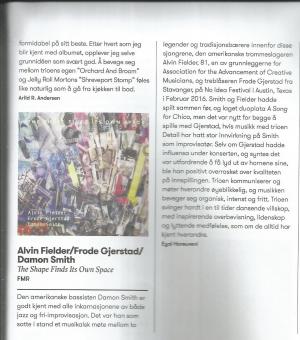Musicians: Birgit Ulher (trumpet, radio, mutes and speaker); Ariel Shibolet (soprano saxophone); Adi Snir (tenor and soprano saxophone); Roni Brenner and Michel Mayer (guitar); Damon Smith (bass and laptop) and Ofer Bymel (drums)
Fraught with extra-musical baggage, the idea of a co-operative session between German and Israeli improvisers seems bizarre. Yet, as these first-rate CDs demonstrate, commitment to free-form experimentation and open-minded sound extension overcomes any number of polemics. The only people who likely will be surprised, shocked or offended by such cross-cultural understanding are those whose ignorance of Middle Eastern realpolitik is likewise endemic.
One of the most notable revelations of these discs is how well Israeli improvisers stack up when playing with the best from other countries: German drummer Günter Baby Sommer on Live in Jerusalem and German trumpeter Birgit Ulher and American bassist Damon Smith on Yclept. Despite ferocious anti-Israeli sentiments in some circles – encompassing in many cases another more pernicious “anti” – these players, based in Tel Aviv and Jerusalem, are as idiosyncratic in their playing and open to new experience as committed improvisers anywhere. Condemning and boycotting them and other artists because of some of their government’s policies is nonsensical. In terms of sound, the Sommer session is more attuned to Free Jazz, while Free Music in its most basic form enlivens Yclept.
Acknowledged as one of the founding fathers of German Free Music, extroverted drummer Sommer has plied his trade with such local and international improvisers as pianists Ulrich Gumpert and Cecil Taylor, saxophonist Peter Brötzmann and trumpeter Wadada Leo Smith. He’s thus perfectly comfortable rolling, ruffing, smacking and stroking his drums no matter the situation. With the CD broken up into duos, trios and quartets – plus one solo drum feature – Sommer pulls out the heavy artillery when playing with soprano and baritone saxophonist Steve Horenstein – a transplanted American who has worked with trumpeter Bill Dixon – and tenor saxophonist and bass clarinetist Assif Tsachar – whose diasporic sojourn took place in New York in the company of heavy-hitters such as pianist Cooper-Moore and bassist William Parker.
Mixing shrill tangents, altissimo cries and subterranean slurs, each reedist takes full advantage of his instrument’s versatility. Hornenstein’s wriggling full-bore improvising abets a fantastic display of rim shots, ricochets and ratamacues from the drummer, while Tsachar shakes out diaphragm-pushed irregular notes half-speed. Other places quivering reed bites and screams face percussion rebounds, rattles and ruffs.
Cross-sticking a martial beat elsewhere, the percussionist’s whaps and resonating verbal cries provide the perfect left-right response to horn players’ creations in double counterpoint. Horenstein’s externally directed slurps and rattling blasts are also a contrapuntal challenge to Tsachar, who exhibits glossolalia-like runs on saxophone, plus sluicing stops on bass clarinet. Mediating on a couple of trio or quartet tracks and keeping the underlined beat steady is bassist JC Jones, who manages to work sul tasto colors in among his walking rhythms.
Just as fascinating is “Yo Yo Yo” with Sommer – who teaches music at the university level in his hometown of Dresden – trading licks with a trio of younger players: tenor saxophonist Yonatan Kretzmer, bassist clarinetist Yoni Silver and guitarist Yonatan Albalak. With an undertow of rumbles and rebounds, the drummer makes common cause with both horns in harmonic unity or when separately Silver puffs out chalumeau yawns and vibrations and Kretzmer sounds hocketing cries and reflux. Distinctively Albalak inflates the soundfield with sprays of slurred tremolo tones plus knob-twisted and wah-wah pedal processed distortions that introduce fortissimo alien wave forms to the interaction.
Sommer’s single run-in with a guitarist is multiplied by two as Ulher and Smith improvise on seven tracks recorded in Tel Aviv with a completely different set of Israeli players. Only soprano saxophonist Ariel Shibolet is a young veteran whose career includes playing with French bassist Joëlle Léandre when she was in Israel and California gigs with Smith, pianist Scott R. Loney and others. Similarly, Oakland-based Smith and Ulher from Hamburg have concertized in Europe and North America, with many older and younger free musicians. Meanwhile Tel Aviv-based guitarists Roni Brenner and Michel Mayer, drummer Ofer Bymel and tenor and soprano saxophonist Adi Snir are so far known, if at all, in Israel.
Proper showcase for all concerned is the 13½-minute fifth improvisation which initially alternates wood-vibrating smacks and sul ponticello sweeps from Smith, rattling smacks from Bymel, yelps and bites from the saxophonists and rubato tongue stretches from Ulher. As her growls and flutters transform into mulched tones and then to gusting grace notes, the saxophonists respond with thin whistling, Smith splatters and rips new textures from his bass –probably helped by laptop wizardry – and the guitarists thump and scratch downwards from strings to pick guards.
Elsewhere electronic wheezes make common cause with plinks plunks and rattles from the guitars as agitato, striated bass motions meet mute or foreshortened breaths, lip burbles or mouthpiece oscillations from the trumpeter. Featuring an equivalent trumpet-saxophone mix that matches moist tongue slaps and mouth percussion with quivering, squeaky reed bites, “Yclept 7” is an even more expressive group improv.
Here the electronic attachments to Ulher’s trumpet project wave forms skywards in counterpoint to agitato and inchoate string rubs from the guitars and dislocated vibrations from Snir and Shibolet. The tenor man swallows bird-like chirping so that it reemerges as thick, guttural blasts, as the soprano saxophonist mixes shrilling reed yelps with timbres that could come from a bagpipe chanter. Smith’s sul tasto rubs then spiccato jabs offset flat-line colored air movement from the saxophonists and Ulher’s tremolo triplets while Bymels’s steadying rat-tat-tats hold the beat and complete the sonic contact.
While it’s true that music may involve socio-political undertones – no matter how pure and questing it may seem – it’s equally true that uniting sophisticated musicians from different milieus can create notable discs like these. Anyone who would boycott artists from any country because of their government’s action is not only guilty of short-sighted malice, but doesn’t have enough faith in art’s transformation power. The 13 musicians represented on these CDs easily make the case for co-operation.
— Ken Waxman
Track Listing: Live: 1. Bojoh#+ 2. Jassek#+& 3. Sommertime 4. Bast#& 5. Yo Yo Yo* 6. Sababa&
Personnel: Live: Yoni Silver (bass clarinet)*; Assif Tsachar (tenor saxophone and bass clarinet)&; Yonatan Kretzmer (tenor saxophone)*; Steve Horenstein (soprano or baritone saxophones)#; Yonatan Albalak (guitar)*; JC Jones (bass)+ and Günter “Baby” Sommer (drums) [all tracks]
Track Listing: Yclept: 1. Yclept 1 2. Yclept 2 3. Yclept 3 4. Yclept 4 5. Yclept 5 6. Yclept 6 7. Yclept 7
Personnel: Yclept: Birgit Ulher (trumpet, radio, mutes and speaker); Ariel Shibolet (soprano saxophone); Adi Snir (tenor and soprano saxophone); Roni Brenner and Michel Mayer (guitar); Damon Smith (bass and laptop) and Ofer Bymel (drums)










